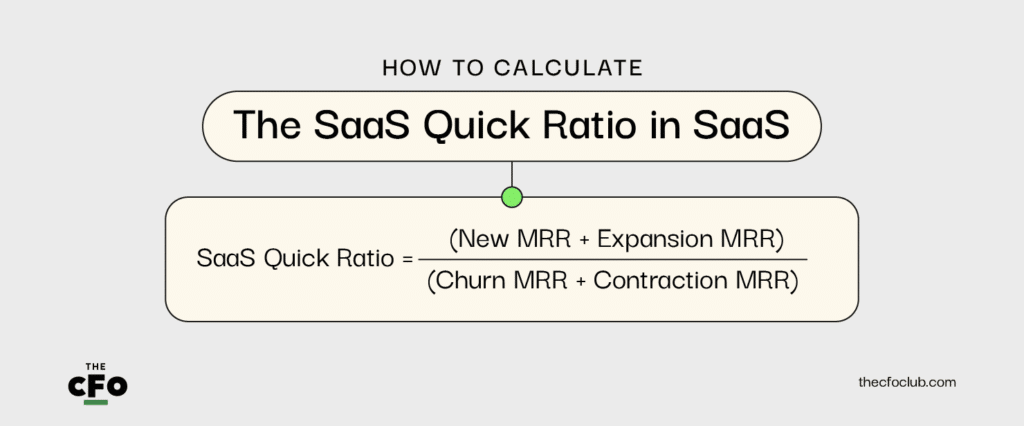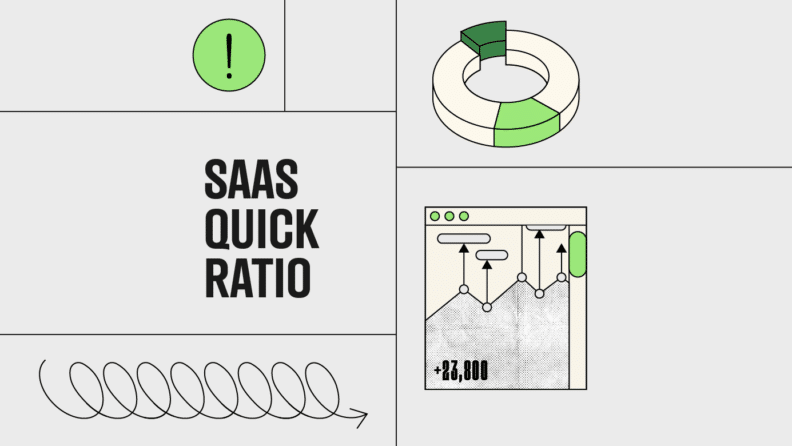The average long-term success of a startup — meaning you make it more than a decade or have a successful IPO — is 10 to 20%.
In fact, 20% of new businesses fail within the first year or two, and only around half make it to the 5-year mark.
You know the usual risks: lack of growth capital, problems bringing the product to market, and poor cash flow. Understanding important metrics, such as the SaaS quick ratio, can help you get a handle on issues like high churn rates before they eat away at your business foundations and create weaknesses that lead to future failure.
What is the SaaS Quick Ratio?
Simply put, the SaaS quick ratio is a metric related to recurring revenue growth. The SaaS quick ratio is designed to help you understand if your growth — the acquisition of new customers — is well balanced with customer stability — the retention of existing customers.
The thing with SaaS companies like yours is that they aren’t just looking for standard revenue growth, they’re striving for long-term recurring revenue. Using the SaaS quick ratio is a fast way to understand how efficiently your business is growing and ensure that your churn rate isn’t creating an unsustainable loop that might create surprises in the future.
Note that this metric is different from the acid test ratio, which sometimes is called the quick ratio. The acid test ratio is similar to the current ratio, in that it helps you understand liquidity by comparing liquid assets against liabilities. For that reason, I'll primarily refer to the ratio we're looking at as the "SaaS quick ratio" instead of simply the "quick ratio".
How to Calculate the SaaS Quick Ratio
Unlike the acid test ratio or current ratio, the SaaS quick ratio doesn’t use basic balance sheet figures like assets and liabilities. Instead, it’s calculated with various revenue figures.
The formula for the SaaS quick ratio is:

I’ll explain what each of those things is.
Monthly Recurring Revenue Components of the SaaS Quick Ratio
The basics: MRR in the SaaS quick ratio formula stands for monthly recurring revenue. That’s how much predictable income you bring in every month with your SaaS product. If you multiply MRR by 12, you get ARR, which is annual recurring revenue.
To calculate the SaaS quick ratio, you must first divide your MRR into four categories. These categories of revenue create the components of the SaaS quick ratio formula:
- New MRR: This is the revenue you earn from new customers who first sign up for or purchase your product within a month. For example, say the cost of your product is $5 per month. In February, you have 200 new customers sign up. That’s $1,000 in new MRR.
- Expansion MRR: This revenue is associated with the expansion of your existing customer base. It refers to revenue created when existing customers select an add-on feature or upgrade to a higher-priced version of your product. If existing free users opt for the paid version, that could be considered expansion MRR.
- Cancellation MRR (aka churned MRR): The flip side of new MRR, this type of revenue loss occurs when existing users cancel their subscriptions.
- Contraction MRR: The flip side of expansion MRR, this type of revenue loss occurs when existing customers downgrade to a lower-priced service level, receive discounts, or otherwise take actions that lower how much they pay for your product in the month.
Why the SaaS Quick Ratio Matters
When you launch a new SaaS business, your first order of business is usually to get users. In fact, it’s common for SaaS startups to offer free versions of the product, at least in the short term, to build excitement and help users see the value in the solution before they try to convert them to customers.
If you have high growth rates, such as thousands of users signing up daily or weekly, this can provide a false sense of success and security. It’s important to keep long-term business health and goals in mind and ensure your user growth isn’t hiding factors that could destabilize the product in the future. The SaaS quick ratio ensures you understand your company’s growth efficiency so you can take proactive steps to protect future viability.
It Helps You Understand MRR Expansion
Imagine a scenario where new revenue is piling up every month. The company’s growth rate seems stellar, and new downloads or bookings are almost more than your team can handle. Your current liabilities and outflow might be a bit high, but that’s normal for a company in a viral growth stage, so all seems right with the world.
Then, a look at your SaaS quick ratio illustrates a concerning picture. You have a low churn rate, which is good. Your revenue is piling up each month because you’re bringing on new customers but the vast majority of them are sticking with the lowest-priced product.
Why is this a concern? First, new customer growth for your product will eventually slow as you reach market saturation. If all your revenue comes from new customers, you’ll have to fight all the harder — and spend more — to drive it. Second, if no one is investing in add-ons or upgrades, your product model may have some issues that need addressing.
It Uncovers Issues Related to Churn
In another example, you might discover that the viral inflow of new customers is masking lost MRR related to a high churn rate.
Eventually, that inflow will slow down, and the fact that customers aren’t sticking around will start hitting your bottom line. Plus, if people aren’t sticking with your product, your customer acquisition (CAC) may be too high for the revenue you’re actually getting from each signup, which means your CAC payback period is getting longer or perhaps not closing the loop at all.
It Informs Investment Viability
One of the goals of many SaaS startups is acquiring funding from venture capitalists or angels. You might also want to grow your business to levels of success such that an IPO is possible. A high quick ratio can help you demonstrate a better chance of success in the future, which can interest investors.
Benchmarking Your SaaS Quick Ratio
The SaaS quick ratio was created by Mamoon Hamid, a venture capitalist. He stated that a good benchmark for the ratio was 4. This means that for every dollar you lose in churn or contraction, you earn $4 in new or expanding revenue.
As a SaaS metric, this benchmark tends to work best for startups that are still in early growth phases but have moved past initial launch. As with any financial benchmark, your business model and industry play a role in what a good SaaS quick ratio might be.
On average, if the ratio is less than 1, your churn rate or downgrade rate is too high compared to your new and expanding revenue, and thus, it’s an indicator that you should take action. A ratio of 1 to 4 indicates unsustainable growth. While you may not need to take immediate action, you definitely can’t let things sit at the status quo.
How to Fix a Low Quick Ratio
In the very early stages of a startup, you can allow your SaaS quick ratio to suffer in the short term as you work to build brand recognition and excitement for your product. However, once you do that, it’s time to really pay attention to monthly recurring revenue and what it says about your customer base, products, and future.
If your company’s quick ratio is low, consider:
- Looking at the customer experience. If retention seems to be the problem, dig into customer experience issues. Are people challenged by complex functionality without the right level of customer support or access to a knowledge base?
- Revamping pricing. If upsells are suffering, consider your pricing model. Are you charging too much for certain levels or do people want a usage-based pricing option, rather than a seat-based one?
- Restructuring product offerings. Pricing isn’t always the problem. It may be that your product offerings don’t align with what users want. Perhaps customer cohort 1 wants a package that offers A, B, and C, while cohort 2 wants a package that offers D and E but the only option you have is a package that offers A, B, D, and E. Conduct research, including customer polls, to find out more.
- Realigning marketing. Ensure your marketing aligns with the intent of your product. If you’re bringing the wrong target audience into your sales funnel, your churn rate will suffer.
Where to Go from Here
The SaaS quick ratio helps you understand your company’s ability to succeed long-term, but it’s not a magic number that exists in a vacuum. Always make business and financial decisions with a clear, holistic picture that also takes into account metrics such as the current ratio, the SaaS magic number, the LTV/CAC ratio, and your company’s liquidity.
Struggling to right your SaaS quick ratio? Connect with other financial leaders on our social media pages to get tips. And sign up for The CFO Club newsletter to get valuable information delivered to your inbox.


